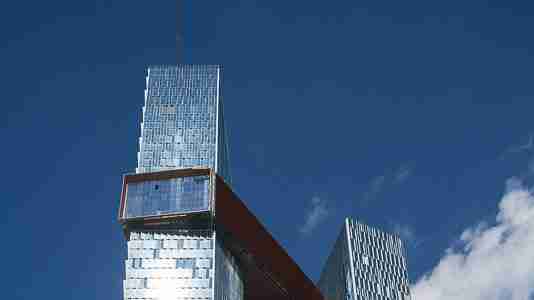What Went into Designing the Headquarters of Tencent, Asia’s Most Valuable Company
Fortune 500 companies spend billions to ensure the proper image of their brand—which is why they often spare no expense when it comes to building their headquarters. And it’s in China, where many newcomers to the Fortune 500 list can be found, that some of the most innovative new offices are located. Near the top of the Fortune 500 list is Tencent, an investment holdings firm that specializes in internet services. Valued at $246 billion, Tencent is Asia’s most profitable company. In 2013, the firm enlisted New York–based architecture group NBBJ to build its new $599 million headquarters in Shenzhen. Scheduled for completion in 2017, the building is connected by a series of skybridges and features such state-of-the-art technology as hologram-led tours of the space. Architectural Digest talked to NBBJ design partner Jonathan Ward about the design of Tencent’s new headquarters.

Architectural Digest: In what way did the day-to-day culture at Tencent factor into the design of the new HQ?
Jonathan Ward: Tencent’s corporate culture is focused on creating innovative products and experiences that help its customers better communicate, shop, socialize, and play. Therefore it was paramount that its cultural emphasis on innovation be echoed and reinforced in the design of its new headquarters. The design draws employees together more frequently and in new ways. The multistory connecting bridges, for example, which intersect at various floors, aren't just visual aesthetics, but they also house most of the common areas for employees to interact.
AD: In New York, SHoP Architects has been constructing a skyscraper that features two buildings and a skybridge meant to suggest a dancing couple. Did any similar themes go into the decision to create multiple skybridges in your skyscraper?
JW: We certainly did not have the theme of a dancing couple in mind when designing the project. The Tencent project is the result of a multiyear design process. The primary drivers for the project were to heighten the sense of community among its employees, increase social well-being, and encourage serendipitous interactions between teams. The critical solution for these desires are the bridge links, which incorporate specific themes such as health, culture and education to help its employees think and work differently than they had before.
AD: Is it true that guests will be ushered through the building through hologram tours?
JW: Yes, that is true. The hologram tours are the result of an initiative to integrate Tencent’s own technology into its headquarters. The technology will help employees and guests more easily navigate the building and take advantage of its many amenities. Since it’s a big advancement in design technology, Tencent is still not ready to release more details about the program.
AD: What are some of the eco-friendly measures you took with this building?
JW: We rotated the original design to take advantage of the site’s prevailing winds to ventilate the atria, while minimizing exposure to direct sun. To control glare and heat gain, the curtain wall incorporates a modular self-shading system that varies based on the degree of sun exposure. Solar and energy modeling were utilized to minimize solar heat gain during intense sun periods. Also, we used a computational design to optimize the amount that the south tower shades the north tower. These and other energy strategies will reduce consumption and carbon emissions by 40 percent over a typical office tower.
AD: What was the most difficult element in designing the HQ?
JW: The Tencent headquarters is located on a tight urban site, which always presents challenges. But perhaps the greatest challenge is one we brought upon ourselves: We sought to use this project to rethink and redefine the corporate high-rise. While great at accommodating lots of people in one place, tall buildings are also notorious for creating barriers between people, teams and departments. As more companies and especially those in the tech industry move into the city, we wanted to create a high-rise design for Tencent that would promote connection, innovation, and health. Using the bridge links, offset cores, a transparent interior design, and advanced elevator systems, the design will help to overcome these barriers.